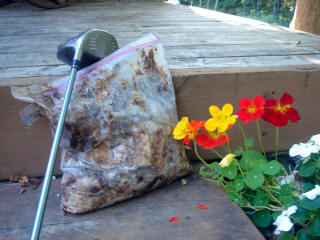 |
This is a lovely blob of new gum. After a
year, it starts to get harder and harder. This is the good stuff, but I
take what I can find.. |
|
The best place to find gum is where branches have
been broken or cut off. When travelling, that means on portage trails and
camping spots. Closer to home, and my favourite spot, is on golf courses.
Hunting for gum is my biggest pleasure playing golf! |
 |
| |
|
|
|
|
 |
Here I am cutting a lump of gum off of the tree.
I catch on a piece of birch bark. This stuff is sticky, so the trick is to try
not to handle it. |
|
Young gum like this is a bit like cold honey in terms of consistency. From
here I put it in a freezer bag. |
|
 |
This is a nice haul harvested in the course of a
clearly successful 9-holes of golf. About three bags of this size are
enough to do a 16 foot canoe. |
|
I load the gum into this pot and heat it up on
the BBQ. I have learned not to do this on the stove in the cabin. It
seems that the family does not appreciate the smell in everything. |
 |
 |
Once melted, which takes a lot of stirring, I pour the gum into a frying pan,
filtering it through some burlap to take out twigs and junk. |
|
Here we are making a kind of
tourniquet
out of the burlap to get all of the gum out. You really don't want gum all
over you during this. Once in the frying pan, one would mix in about a
tablespoon of bear (or bacon) fat. |
 |
 |
Here Tom is starting to gum the canoe that I took
on the Northern Saskatchewan trip. Some people add ashes to the gum.
I do not. Bad idea if the gum runs. Looks like tar! |
|
The gum takes a fair bit of careful maintenance
if you want to keep things dry. You don't always need to add gum.
Here Jim is heating up the existing gum which he will rework with his fingers. |
 |
 |
You always travel with extra gum, and collect it
en route. Here, Jim and I are fixing two gashes in my canoe (hidden rock
in eddy in a rapid, sigh). |
|
Notice Jim licking his fingers in the previous
image. Saliva on them keeps the gum from sticking to them. Here you
see him working the gum into the "seam". |
 |